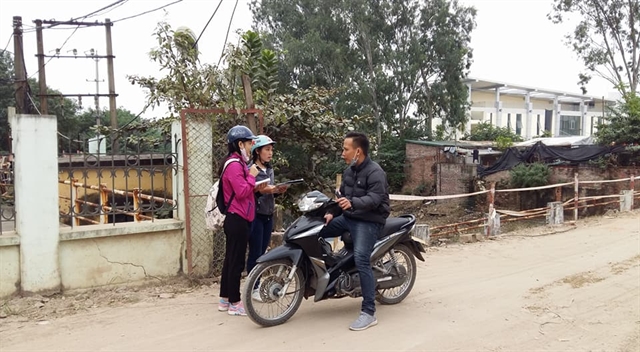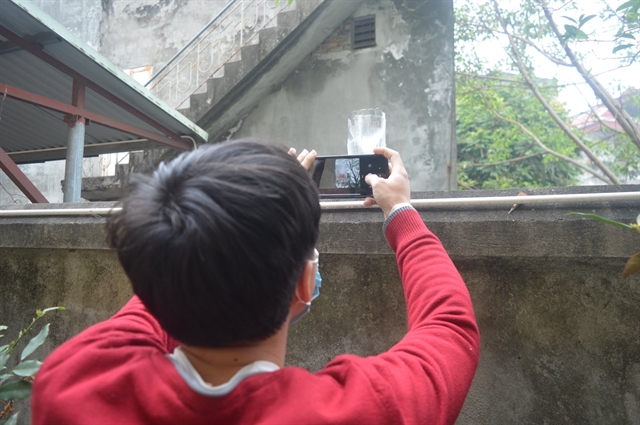 Opinion
Opinion


|
| Two students of Hà Nội University of Natural Resources and Environment interviewed a local about the water situation in their living area in the outskirts of Hà Nội. Photo courtesy of Phạm Oanh |
In a recent interview with Việt Nam News, Assoc. Prof. Ph.D. Phạm Quý Nhân, Vice-Rector of Hà Nội University of Natural Resources and Environment spoke to Vân Nguyễn about the participation of local communities in environmental protection activities and the potential of applying a community science approach in the environment sector in Việt Nam.
To put it simply, community science involves the participation of citizens who have little or no scientific background in collecting data for a scientific project. How is this approach being used in Việt Nam?
Community science or citizen science is still new in Việt Nam. A form of this model has been used by VOV traffic channel which broadcasts live traffic information and traffic congestion warnings. This programme allows citizens to share information on the traffic situation so road users can avoid traffic jams and find a suitable route or time instead.
I have also seen some organisations and teams in Đà Nẵng City which encourages the local community to share information to help tackle urban issues.
In the environment sector, starting from 2016, my colleagues and I used community science in water management research projects. In recent years, this model has also been used in monitoring water levels in Nhuệ River based on the pictures taken and shared by the local community. Other areas also using this model include land classification and use and water quality analysis.
These projects show the potential of citizen science in complementing traditional data collection methods in an effective way. This model also helps improve the accuracy and reduce the cost of data collection.
As one of the leading higher education institutions on the environment, how has this been done at HUNRE?
In recent years, Hà Nội University of Natural Resources and Environment has implemented international cooperation projects with the Netherlands. We had a programme to strengthen the capacity of the Water Resources University and the HUNRE in 2012-2016 within the framework of the Strategic Partnership Agreement in water management and climate change between Việt Nam and the Netherlands. Another one being implemented is about the cooperation in education towards the goal of sustainable development in 2018-2022 under the Orange Knowledge Programme.
Through these collaborative projects, we have used new approaches and new methods in water resources research. Since 2016, we have applied community science to research and taught it in water resource management faculty and achieved initial results.
We have a study on Citizen Science on Water Resources Monitoring in the Nhuệ River. Nearly 100 people who are lecturers, students from our university’s water resource faculty, students from the Netherlands’ Delft University of Technology, and the local community living in the study area participated in this research. Currently, our lecturer Trần Ngọc Huân and lecturers of water resource faculty continue to apply the community science in assessing the impacts of urbanisation on some flood areas. This is also the Ph.D. thesis of lecturer Huân who is studying and doing research in Germany.
What are the limitations of this approach?
There are some limitations of community science regarding the engagement of the community, quality of data and cost to maintain and develop this model.
The engagement of the community in a project may reduce over time and may not over a long period of time. Living conditions and educational background are among the most important aspects of volunteering and these factors vary from region to region. Some projects would need funding to support the citizens to encourage them to participate in collecting data regularly.
Community science studies require great effort in preparation, communication to gain public interest, persistent guidance, and training of participants to collect data in an efficient manner.
Great efforts in preparation and communication are needed to encourage community science to attract attention and encourage the community to join. Training for the participants in collecting data to ensure accuracy and quality also is necessary.

|
| A local resident in the outskirts of Hà Nội is collecting precipitation data for a citizen science project. Photo courtesy of Huân Trần |
Which factors drive the development of this model in Việt Nam?
Smartphone improvement and popularisation have enabled the development of mobile apps focused on technical and scientific functions. Smartphones have been used popularly and widely in not only developed but also many developing countries.
It allows users to determine coordinates, helps to display survey locations on the map, while sensors enable us to record images and information. Sometimes applications can also analyse results based on images. The use of the data collection application ensures consistency and reliability. In addition, mobile applications are often connected and shared via social networks, displayed on the website, helping many people access information about the research.
Nowadays we can find a number of free data collection applications available including ODK Collect, Kobo Collect, Hidromapp. Data collection applications on smartphones have been applied in a variety of fields like nature, health, and air quality.
Why is community science important in the environment sector? What are the factors that hold back the development of this model in Việt Nam?
With the rise of mobile devices and Web 2.0, community science has been applied more popularly, providing valuable data and information in hydrology, water resources.
Depending on the objectives of the research, the community can participate in providing and collecting different information. It can be quantitative data on rain, water level, water quality.
In addition, data collected by the community can also be used for studies on flood risk assessment. In recent years, the application of community science in collecting flood data is quite popular in many different continents.
Most of the studies I mentioned used smartphones, making it easy for participants to actively participate in the monitoring process.
In Việt Nam this is applied on a small scale as it has been introduced to Việt Nam just recently. The data collection applications are developed by foreigners and some are not friendly to local users. In addition, we also need more encouragement and recognition from as well as the specific policies from the Government on developing this.

|
| A photo taken by a citizen shows the low water level in Nhuệ River last December. Photo courtesy of Huân Trần |
What needs to be done to further develop this model in Việt Nam and which stakeholders are responsible for it?
In Việt Nam, this model is yet used widely. Some studies are just on a pilot stage and haven’t used data collection applications to collect, process and store information in a systematic way.
To develop this model, we need efforts from many stakeholders. Scientists and researchers should use this more. With many advantages, this can be applied effectively in many fields. We should also raise the awareness of the local community so they understand the benefits when participating in the project, whose result is to serve the community. It is also important to develop data collection applications that are friendly to local users. In addition, the government should also issue instructions and in the long term, consider community science a tool to solve scientific tasks and issues.
The increasing popularity of community science can be explained by a number of elements. In recent years, new developments in sensing technology, data processing and analysis, and knowledge communication have opened new pathways for citizen science.
By participating in research projects, the local citizens also have the chance to enhance their understanding of local issues. This can also provide the local community the opportunity to participate in decision-making and planning. Community science also has great potential in constructing risk mitigation and response strategies. Therefore, the shift from top-down to bottom-up policy in the environment sector, in some cases, is necessary. — VNS




